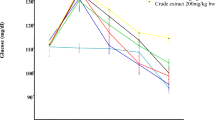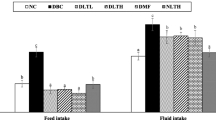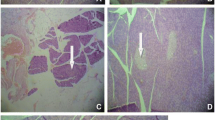Abstract
The anti-diabetic effect of the drug Semecarpus anacardium Linn nut milk extract (SA) was studied in male Sprague Dawley rats. The rats were divided into seven groups of six animals each. Type 2 diabetes mellitus was induced in rats by feeding them with a high fat diet for 2 weeks followed by intraperitoneal injection of 35 mg/kg/body weight (b. wt.) of streptozotocin. The diabetic rats were treated with the drug at four different concentrations of 100, 200, 300 and 400 mg/kg/b. wt. respectively and were compared with the diabetic rats treated with the standard drug metformin for 30 days. Diabetic rats showed an increase in blood glucose levels, increased levels of glycosylated haemoglobin (HbA1c) and impaired glucose tolerance and an increase in lipid profile. The blood glucose level and glycosylated haemoglobin levels were lowered in the diabetic rats treated with the drug SA, and also, an improvement in glucose tolerance test was observed. The drug also effectively lowered the lipid profile level. The effect of the drug was found to be effective at the dosage of 200 mg/kg/b. wt. showing an increase in insulin levels. This suggests the potential anti-diabetic effect of the drug.
Similar content being viewed by others
References
Anonymous (1972) Formulary of Siddha medicine, 2nd edn. Indian Medicine Practitioners Co-operative Pharmacy and Stores Ltd., Madras, 197
Aragno M, Mastrocola R, Catalano MG, Brignardello E, Danni O, Boccuzzi G (2004) Oxidative stress impairs skeletal muscle repair in diabetic rats. Diabetes 53:1082–1088
Aravind SG, Arimboor R, Rangan M, Madhavan SN, Arumughan C (2008) Semi-preparative HPLC preparation and HPTLC quantification of tetrahydroamentoflavone as marker in Semecarpus anacardium and its polyherbal formulations. J Pharm Biomed Anal 48(3):808–813
Arul B, Kothai R, Christina AJ (2004) Hypoglycemic and antihyperglycemic effect of Semecarpus anacardium Linn in normal and streptozotocin-induced diabetic rats. Methods Find Exp Clin Pharmacol 26:759–762
Banerji MA, Lebovitz HE (2001) Treatment of insulin resistance in diabetes mellitus. Eurr J Pharmacol 490:135–146
Chattopadhyaya MK, Khare RL (1969) Isolation of anacardic acid from Semecarpus anacardium Linn. and study of its anthelmintic activity. Ind J Pharm 31:104–105
Chattopdhay RR (1993) Hypoglycemic effect of Ocimum sanctum leaf in normal and streptozotocin diabetic rats. Indian J Exp Biol 31:891–893
Du Vigneaud V, Karr WG (1925) Carbohydrate utilization rate of disappearance of d-glucose from the blood. J Biol Chem 66:281–300
El Hajji H, Nkhili E, Tomao V, Dangles O (2006) Interactions of quercetin with iron and copper ions: complexation and autoxidation. Free Radic Res 40:303–320
Elgawish A, Glomb M, Freelander M, Monnier VM (1996) Involvement of hydrogen peroxide in collagen cross-linking by high glucose in vitro and in vivo. J Biol Chem 271:12964–12971
Folch J, Less M, Stanely GHS (1951) A simple method for the isolation and purification of total lipids from animal tissues. J Biol Chem 226:49–509
Frendell MS, Glazer NB, Zhan YE (2003) Combination therapy with pioglitazone plus metformin or sulfonylurea in patients with type 2 diabetes influence of prior antidiabetic drug regimen. J Diabetes Complicat 17:211–217
Goldstein DE, Little RR, Lorenz RA, Malone JI, Nathan DM, Peterson CM (2004) Tests of glycemia in diabetes. Diabetes Care 27:S91–S93
Hall PM, Cook JGH, Sheldon J, Rutherford SM, Gould BJ (1984) Glycosylated hemoglobin and glycosylated plasma proteins in the diagnosis of diabetes mellitus and impaired glucose tolerance. Diabetes Care 7:391–393
Horn WT, Menahan LA (1981) A sensitive method for the determination of free fatty acids in plasma. J Lipid Res 22:377–381
Indap MA, Ambaye RY, Gokhale SV (1986) Potentiation of activity of anticancer drugs by acetylated oil of Semecarpus anacardium Linn. F. in experimental tumours. Indian Drugs 23:447
Jaya A, Shanthi P, Sachdanandam P (2010) Modulation of oxidative/nitrosative stress and mitochondrial protective effect of Semecarpus anacardium in diabetic rats. JPP 62:1–7
Kanters SDJMN, Banga JD, Erkelens DW (2001) Lipid-lowering therapy in diabetes mellitus. Neth J Med 58:214–222
Kothai R, Arul B, Kumar KS, Christina AJ (2005) Hypoglycemic and antiperglycemic effects of Semecarpus anacardium linn in normal and alloxan-induced diabetic rats. J Herb Pharmacother 5(2):49–56
Lo H-C, Shih-Te Tu, Lin K-C, Lin Su-Chen (2004) The anti-hyperglycemic activity of the fruiting body of Cordyceps in diabetic rats induced by nicotinamide and streptozotocin. Life Sci 74:2897–2908
Murthy SSN (1992) New biflavanoid from Semecarpus anacardium Linn. Clin Acta Turcica 20:33–37
Mythilypriya R, Shanthi P, Sachdanandam P (2008) Synergistic effect of Kalpaamruthaa on antiarthritic and antiinflammatory properties—its mechanism of action. Inflammation 31:391–398
Nair PKR, Melnick SJ, Wnuk SF, Rapp M, Escalon E, Ramachandran C (2009) Isolation and characterization of an anticancer catechol compound from Semecarpus anacardium. J Ethnopharmacol 122(3):450–456
Pari L, Rajarajeswari N (2009) Efficacy of coumarin on hepatic key enzymes of glucose metabolism in chemical induced type 2 diabetic rats. Chem Biol Interact 181(3):292–296
Parkeh AC, Jung DH (1970) Cholesterol determination with ferric chloride uranium acetate and sulphuric acid—ferrous sulphate reagents. Anal Chem 42:1423–1427
Parveen K, Khan MR, Mujeeb M, Siddiqui WA (2010) Protective effects of Pycnogenol on hyperglycemia-induced oxidative damage in the liver of type 2 diabetic rats. Chem Biol Interact 186:219–227
Prakasa Rao NS, Ramachandra Row L, Brown RT (1973) Phenolic constituents of Semecarpus anacardium. Phytochemistry 12:671–681
Premalatha B (2000) Semecarpus anacardium Linn. nuts—a boon in alternative medicine. Indian J Exp Biol 38:1177–1182
Pushparaj PN, Low HK, Manikandan J, Tan BKH, Tan CH (2007) Anti-diabetic effects of Cichorium intybus in streptozotocin induced diabetic rats. J Ethnopharmacol 111:430–434
Rai MK, Pandey AK, Acharya D (2000) Ethno-medicinal plants used by gond tribe of Bhanadehi. District Chhindwara. Madhya Pradesh J Non-Timber Forest 7:237–241
Ramprasath VR, Shanthi P, Sachdanandam P (2005a) Evaluation of antioxidant effect of Semecarpus anacardium Linn. nut extract on the components of immune system in adjuvant arthritis. Vasc Pharmacol 42(4):179–186
Ramprasath VR, Shanthi P, Sachdanandam P (2005b) Evaluation of antioxidant effect of Semecarpus anacardium Linn nut extract on the components of immune system in adjuvant arthritis. Vascul Pharmacol 42:179–186
Rao P, Pattabiraman TN (1990) Further studies on the mechanism of phenol-sulfuric acid reaction with furaldehyde derivatives. Anal Biochem 189:178–181
Raveedran Nair PK, Melnick SJ, Wnuk SF, Rapp M, Escalon E, Ramachandran CJ (2009) Isolation and characterization of an anticancer catechol compound from Semecarpus anacardium. Ethnopharmacol 122:450–456
Reed MJ, Meszaros K, Entes LJ, Claypool MD, Pinkett JG, Gadbois TM, Reaven GM (2000) A new rat model of type2 diabetes: the fat-fed streptozotocin-treated rat. Metabolism 49:1390–1394
Rice EW (1970) Triglycerides in serum. In: Roderick P, Mac-Donald CH (eds) Standard methods of clinical chemistry, 6th edn. Academic, New York, pp 215–222
Robertson RP (2007) Estimation of beta-cell mass by metabolic tests: necessary, but how sufficient? Diabetes 56:2420–2424
Sahoo AK, Narayanana N, Sahanaa S, Rajanb SS, Mukherjee PK (2008) In vitro antioxidant potential of Semecarpus anacardium. L Pharmacologyonline 3:327–335
Satyanarayana T, Katyayani BM, Latha HE, Mathews AA, Chinna EM (2006) Hypoglycemic and antihyperglycemic effect of alcoholic extract of Euphorbia leucophylla and its fractions in normal and in alloxan induced diabetic rats. Phcog Mag 2:244
Selvam C, Jachak SM (2004) A cyclooxygenase (COX) inhibitory biflavonoid from the seeds of Semecarpus anacardium. J Ethnopharmacol 95:209–212
Sharma B, Nasir A, Prabhu KM, Murthy PS, Dev G (2003) Hypoglycaemic and hypolipidemic effect of ethanolic extract of seeds of Eugenia jambolana in alloxan-induced diabetic rabbits. J Ethnopharmacol 85:201–206
Shin YG, Cordell GA, Dong Y, Pezzuto JM, Appa Rao AVN, Ramesh M, Ravi Kumar B, Radhakishan M (1999) Rapid identification of cytotoxic alkenyl catechols in Semecarpus anacardium using bioassay-linked high performance liquid chromatography-electrospray/mass spectrometric analysis. Phytochem Anal 10(4):208–212
Singleton JR, Smith AG, Russell JW, Feldman EL (2003) Microvascular complications of impaired glucose tolerance. Diabetes 5(2):2867–2873
Soltani N, Keshavarz M, Dehpour AR (2007) Effect of oral magnesium sulphate administration on blood pressure and lipid profile in streptozotocin diabetic rat. Eur J Pharmacol 560:201–205
Srinivasan K, Viswanad B, Lydia A, Kaul CL, Ramarao P (2005) Combination of high-fat diet fed and low-dose streptozotocin-treated rat: a model for type 2 diabetes and pharmacological screening. Pharmacol Res 52:313–320
Tahrani AA, Piya MK, Kennedy A, Barnett AH (2010) Glycaemic control in type 2 diabetes: targets and new therapies. Pharmacol Ther 125:328–361
Taniguchi CM, Emanuelli B, Kahn C (2006) Critical nodes in signalling pathways: insights into insulin action. Nat Rev Mol Cell Biol 7:85–96
Tapas AR, Sakarkar DM, Kakde RB (2008) Flavonoids as nutraceuticals a review tropical. Journal of Pharmaceutical Research 7(3):1089–1099
Tominaga M, Eguchi H, Manaka H, Igarashi K, Kato T, Sekikawa A (1999) Impaired glucose tolerance is a risk factor for cardiovascular disease, but not impaired fasting glucose The Funagata Diabetes Study. Diabetes Care 22:920–924
Trinder P (1969) Determination of blood glucose using an oxidase-peroxidase system with a non-carcinogenic chromogen. J Clin Pathol 22:158–161
Umarani M, Shanthi P, Sachdanandam P (2008) Protective effect of Kalpaamruthaa in combating the oxidative stress posed by aflatoxin B1-induced hepatocellular carcinoma with special reference to flavonoid structure-activity relationship. Liver Int 28(2):200–213
Van Handle E (1961) Modification of the micro determinating triglycerides. Clin Chem 7:249–251
Vessal M, Hemmati M, Vasei M (2003) Antidiabetic effectsof quercetin in streptozocin induced diabetic rats. Comp Biochem Physiol C 135:357–364
Wild S, Roglic G, Green A, Sicree R, King H (2004) Global prevalence of diabetes: estimates for the year 2000 and projections for 2030. Diabetes Care 27:1047–1053
Xie WD, Du LJ (2005) High-cholesterol diets impair short-term retention of memory in alloxan-induced diabetic mice, but not acquisition of memory in prediabetic mice. Life Sci 77:481–495
Author information
Authors and Affiliations
Corresponding author
Rights and permissions
About this article
Cite this article
Khan, H.B.H., Vinayagam, K.S., Palanivelu, S. et al. Anti-diabetic effect of Semecarpus anacardium Linn nut milk extract in a high fat diet STZ-induced type 2 diabetic rat model. Comp Clin Pathol 21, 1395–1400 (2012). https://doi.org/10.1007/s00580-011-1305-5
Received:
Accepted:
Published:
Issue Date:
DOI: https://doi.org/10.1007/s00580-011-1305-5




